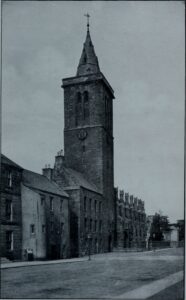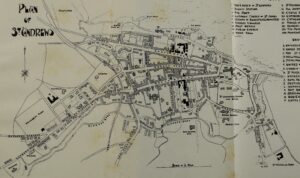Esperanto was a bridge, a connector of worlds, peoples and places. The transnational network that sprouted around this international language was diverse, proactive, and above everything else interested in not only learning about foreign issues, but also showing their little communities to the rest of humanity. On the pages of the many journals that were published in the early years of the movement, articles about the big cities shared the space with pieces that put a spotlight on small towns that otherwise would have rarely been discussed in the international press. J. T. Haxton, a merchant who lived at 133 South Street, St. Andrews, made sure to include his hometown in his writings in Esperanto.

Haxton learnt the auxiliary language in 1901 and soon became an honorary secretary listed on the publications of The Esperantist: La Esperanta Gazeto por la Propagando de la Internacia Lingvo. In February 1905 he contributed to this journal with an article titled ‘St. Andrews en Somero” (“St. Andrews in Summer”). In an issue that included texts about China, India, and Margarita Island in Venezuela, Haxton penned an essay that painted an idyllic picture of the ‘ancient gray town by the sea’.
In over six hundred words, the merchant described South Street as a vibrant place ‘adorned with vases of flowers’ and ‘flanked by now leafy linden trees’ where ‘the bright summer dresses of women’ and the ‘fluttering laughter of children’ completed the scenery. Colorful descriptions such as this one were a common occurrence in Esperanto journals as the writers often played with the language in an attempt to test its flexibility and artistic capacity. Nonetheless, this was not the only reason.
These compositions were a new way of attracting tourists, and through intricate wording and carefully chosen adjectives, Esperantists aimed at creating an image of their lands that would captivate foreigners. In this spirit, Haxton did not hesitate to include references to the most distinctive landmarks of the town, including ‘the ancient gate, well preserved, where the silver locks of the city were presented to King Charles II in 1650’ and ‘the remnant of the vast cathedral, which was destroyed during the Reformation, and it still noble in its ruins.’ References to the historical past of the town helped Haxton present an enigmatic town where ‘the places where the witches drowned and where the tortured were burned’ were still shown.

Despite the passage of time, the scenes described by Haxton evoke a St. Andrews that is not so different from the one we know today. He spoke of carriages that were bound for Crail and Dura Den, and of the ‘clean and well-kept shops’ that made of South Street a ‘real sight in summer’. Yet this Esperantist mainly focused on what later became the object of his next publication in the French Esperanto journal Tra la Mondo the following September: golf.
The variety of topics often discussed in Esperanto publications included not only cultural, scientific and linguistic issues, but also leisure activities such as sports. In ‘St. Andrews en Somero’ Haxton referred to the ‘golf fever’ that had brought people from everywhere to play the ‘game of kings’ in St. Andrews. Thus, gold had become something more than a game, it was the backbone of the community.
In ‘La “Golf”-ludo en St. Andrews (Skotlando)’, the piece published by Tra la Mondo in September 1905, Haxton further explored the sport by delving into the mechanics of the game, which he described as being ‘a feature of the present time’. Knowing that his audience would be more international than with The Esperantist and thus less likely to understand what it was about, Haxton recreated an immersive experience for his readers in which they were invited to imagine themselves visiting St. Andrews and playing for the first time. Haxton guided the reader through the game, from the first minutes spent watching other players struggling to hit the ball to the last of eighteen holes.
The article was printed alongside texts about Beziers (France), Vevey (Switzerland), and Sicily (Italy) among others that had been penned by other local Esperantists. The ample range of issues discussed in periodical publications such as The Esperantist and Tra la Mondo is a testimony to the multidimensionality of the members of the Esperanto community. Every contributor brought with themselves their own experiences, backgrounds, and interests, which helped shape a transnational network in which diversity thrived.
With a secondary language that was easy to learn as their main instrument, no writer had an unfair advantage granted exclusively by their mother tongue. Journals like Tra la Mondo, in which every article was written by a collaborator from a different nationality, could easily exist and work without spending extra money on translations thanks to Esperanto. Basically, Esperantism opened the door to a world full of possibilities.
Primary sources:
J.T. Haxton,
‘La “Golf”-ludo en St. Andrews (Skotlando)’, in Capé, Auguste, Oxenford, Caroline (eds.), Tra la Mondo(September 1905), pp. 42-43.
‘St. Andrews en Somero’, in Mudie, H. Bolingbrokem (ed.), The Esperantist: the Esperanto Gazette for the Spreading of the International Language (February 1905), p. 31.
